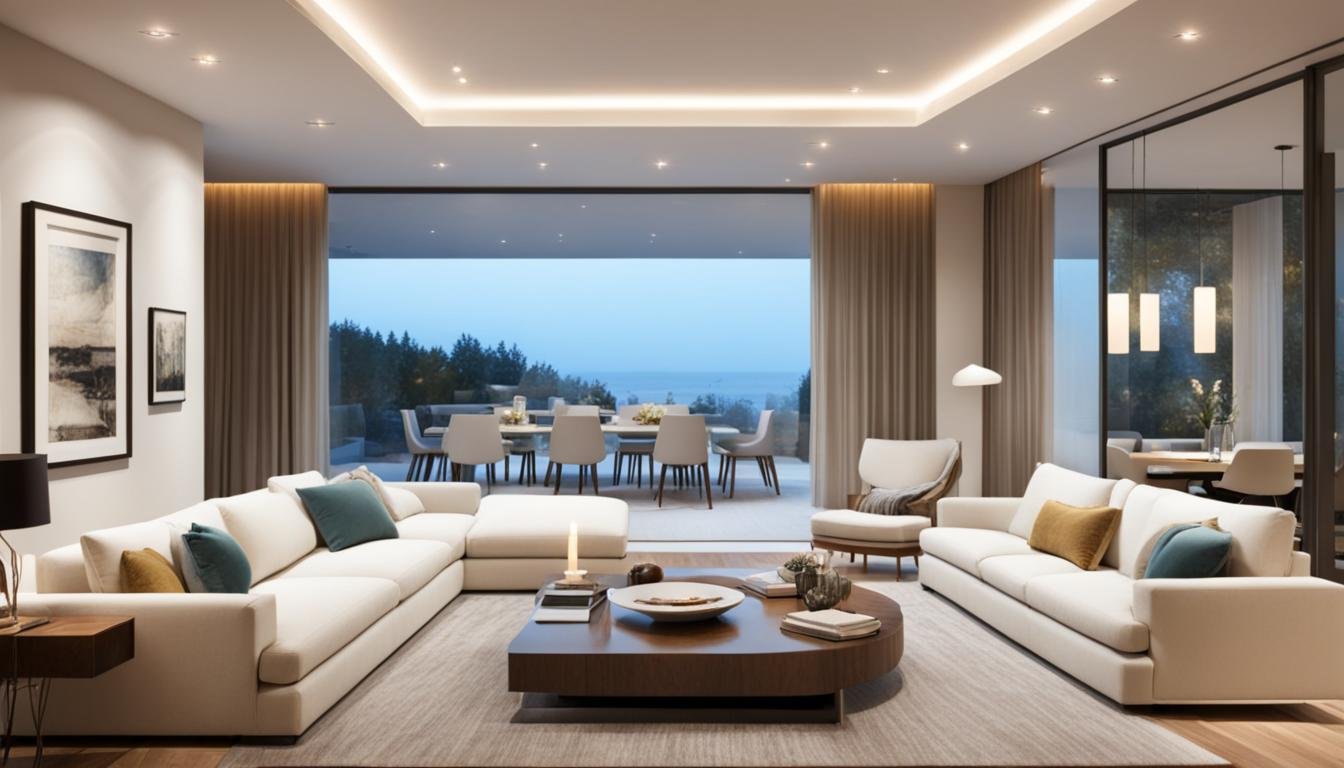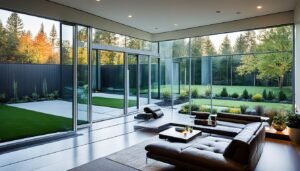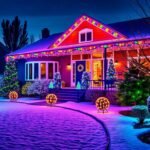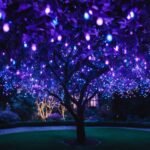Do you wish to change your old ceiling lights to something sleeker? Recessed lights, also called downlights, fit into your ceiling for a clean look. They merge well with your home’s design. But with many types out there, choosing the right one can be tough. This guide will show you how to pick the best recessed lighting for your place.
Key Takeaways
- Recessed lights work great in rooms with low ceilings and keep the space looking neat.
- There are different housing types, from new construction to remodel and IC rated for insulation contact.
- You can pick from various trims like baffle, reflector, or open to get the style you want.
- For general lighting, 6-inch fixtures are the most used.
- LED lights are a smart choice because they save energy and last a long time.
Check out our FREE Calculators on our Resources Page
Deciding on recessed lighting can be hard, but we’re here to make it easier. This guide covers everything you need to know. You’ll learn about different housings, trims, color temperatures, and how to install them. With this info, you can upgrade your home with the right recessed lights!
Wondering how to set up the perfect recessed lighting in a room? How many lights do you need for good room illumination? We’ll give you the answers to plan the best lighting for your area.
Understanding Recessed Lighting
Recessed lights, also called recessed ceiling lights or downlights, fit into the ceiling. This creates a clean, modern look. Homeowners like them because they have many advantages.
What are Recessed Lights?
Recessed lights are in the ceiling, making them level with the surface. They look sleek and don’t stand out. This makes any room look better.
Benefits of Recessed Lighting
Recessed lighting brings several key advantages:
- It aims light straight down. So, it’s efficient and bright where you need it most.
- Since they’re flush, they don’t lower your room’s height. This is perfect for rooms with low ceilings.
- You can place them to light up tasks, spots, or the whole room.
- They add a neat, simple touch that works with any style, like modern or traditional.
Adding recessed lights is great for a new home or a fixer-upper. They improve how rooms look and work.
Types of Recessed Lighting Housings
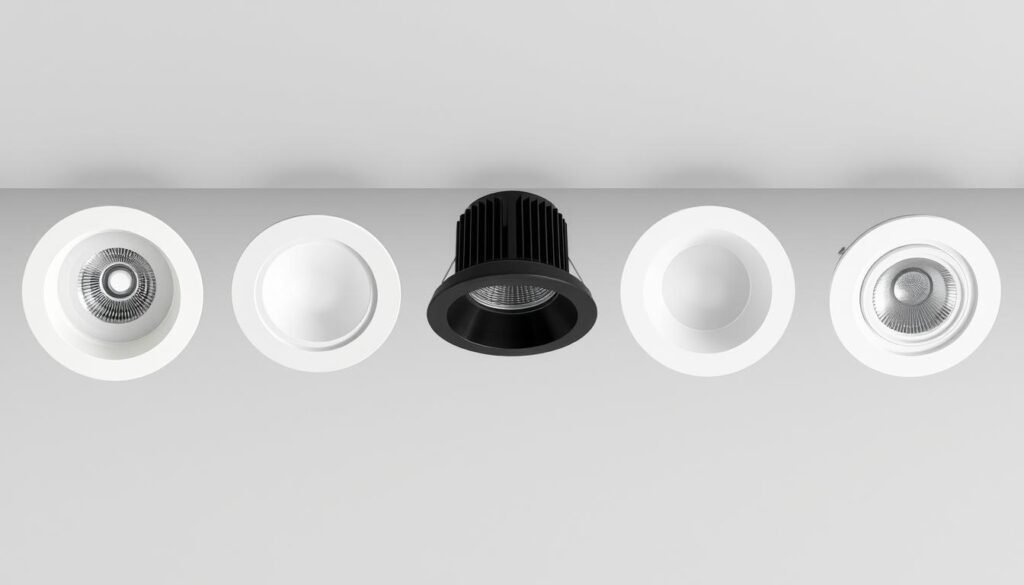
The housing in a recessed light is super important. It’s the fixture that’s above the ceiling. It holds the light bulb and trim. You have many choices in this, with each type offering different benefits.
New Construction Housing
New construction housings are for new homes or big renovations. You must have access to the ceiling from above to install these. You attach them to ceiling joists. They give a neat look and are usually the cheapest option for new lights.
Remodel Housing
Remodel housings let you add new lights without messing with the ceiling much. They go in from below, perfect for spaces with finished ceilings. They’re a great way to update your lighting with less hassle.
Insulation Contact (IC) Rated Housing
IC-rated housings can touch insulation without any worry. They’re all about safety and saving energy. They’re a must for homes with insulated ceilings, keeping things safe and sound.
Non-IC Housing
Non-IC rated housings keep away from insulation. This prevents them from getting too hot. They’re a fine choice for homes without insulation. They can save you some money where safety is not a concern.
Airtight Housing
Airtight housings stop air from leaking through. This feature helps your home use energy better. They’re ideal in strict energy areas. They help keep your heating and cooling inside, saving you money.
Recessed Lighting Trim Options
The part of the light you see first is called the trim. It creates the outer circle on the ceiling. Various recessed lighting trim styles are available. Each type meets different lighting needs and serves its own function.
Baffle Trim
For general lighting, many choose baffle recessed lighting trim. This style has ridges that cut down on glare. They also soften the light, spreading it gently around the room.
Reflector Trim
Reflector trim works well for lighting up specific areas. It’s designed to concentrate and aim the light. With its shiny surface, it bounces light for better brightness and less energy use.
Open Trim
The simplest option, known as open trim, offers a sleek, minimal look. It emits a broad, gentle light. This makes it great for lighting up larger spaces.
Recessed Lighting Sizes
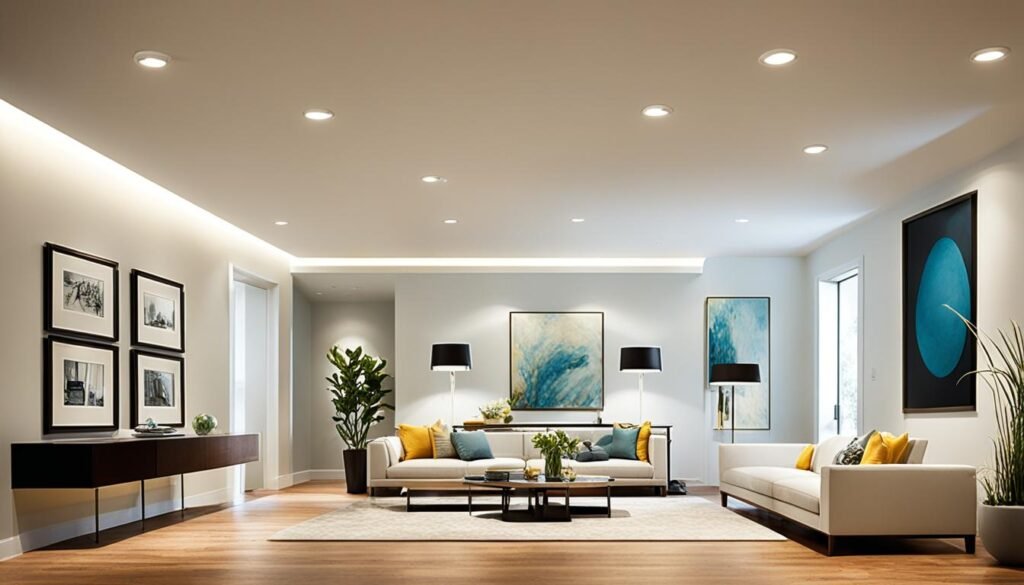
Choosing the right recessed lighting size is key. You can pick from 3 inches to 6 inches wide. Your choice depends on your room’s height and use.
Residential sizes for recessed lights are normally 4-inch, 5-inch, and 6-inch wide. Pick these to match your lighting needs and room look.
Most 4-inch housings are about 5-1/2 inches high. On the other hand, 5-inch and 6-inch ones are about 7-1/2 inches tall. The size affects how deep the light goes into your ceiling.
Remember the ceiling cut-out size for each light too. For instance, 4-inch lights need a 4-3/8 inch cut-out. 5-inch needs 5-5/8. And 6-inch lights require a 6-3/8 inch cut-out. Having the correct cut-out size is essential for a neat, pro set-up.
Though 4-inch, 5-inch, and 6-inch are common, you might see 2-inch and 3-inch recessed lights for special uses. Plus, 8-inch lights are more for businesses and shine brighter.
For canless LED recessed lights, just look at the cut-out size to figure out the light’s diameter. Always round to the nearest whole number.
Recessed Lighting Color and Temperature
Color temperature matters a lot in recessed lighting. Recessed lights come in various temperature options. These include Warm White (2700K), Soft White (3000K), Cool White (4000K), and Daylight (5000K). Warm white and soft white are similar to regular incandescent bulbs. They make your space feel cozy and inviting.
Soft White
For a warm and welcoming vibe, choose soft white lights in the 3000K range. They’re perfect for places like living rooms and bedrooms where you want to relax. This color makes your spaces feel comfy.
Bright White
If you need light that’s brighter and more invigorating, try lights with a 4000K color. This cooler light is good for places like kitchens and offices. It can help improve focus and efficiency.
Daylight
Daylight lights, around 5000K, give off a clear light like the sun. This kind of light helps you stay alert and focused. It’s great for home offices or areas where you work on tasks.
When you pick a color temperature for your lights, think about the space’s mood and use. Try out different lights to get the right mix of feel and function in your home.
recessed lights guide
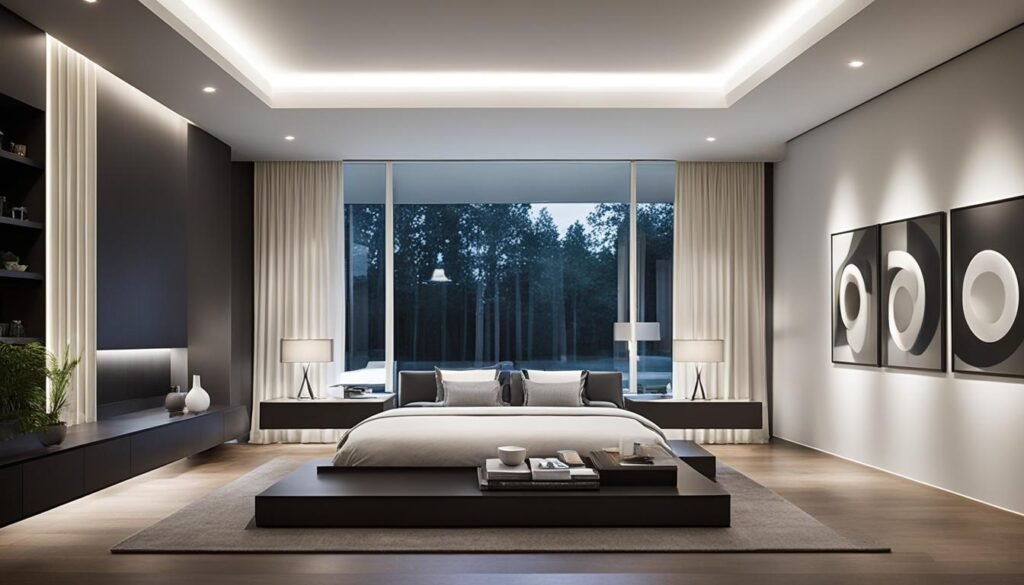
This recessed lights guide covers everything about this type of lighting. It includes info on different housings, trim choices, and sizes. It also talks about colors, temperatures, and where to put them in your home. If you’re building anew or updating a space, this guide will help. It aids in choosing the right lights for your needs and style.
When adding recessed lights in new places, they go between the ceiling joists. But, you can also put them in existing ceilings. A key point is to space them out right. For example, lights on an 8-foot ceiling should be 4 feet apart. There are many types of trims, like baffle and reflector ones. Plus, you’ll find various sizes, from 4 inches to 9 inches, for different uses.
Recessed lights come in cool, warm, and natural light colors. They can be changed to fit your mood or activity. This makes them perfect for kitchens, bathrooms, living rooms, and outside areas. Each area has special suggestions for lighting. Sticking to LED lights saves energy. These lights last a long time without needing bulbs replaced. You can pick from models with built-in LEDs or kits to change to LED lights.
It’s common to use 4 to 9 lights for general lighting. Each number creates a different lighting design. For workspaces, it’s suggested to evenly space the lights above the work area. When highlighting, place lights evenly and use adjustable trims to focus the light where you want it. If you have a slanted ceiling, special trims can adjust the light’s angle. This reduces any glare. For TVs, having two lighting zones stops any glare. This way, you can control the light around the TV better.
Recessed lights usually come in 3 to 6-inch sizes. LED lights last a long time and get dimmer as they age. They are also energy-saving, meaning lower bills than with traditional bulbs. Canless lights are a sleek choice that goes well with many styles. Things like color temperature affect how a room looks under the light. Small lights work well with modern designs. They’re great for adding extra light or highlighting certain spots.
Recessed Lighting for Different Rooms
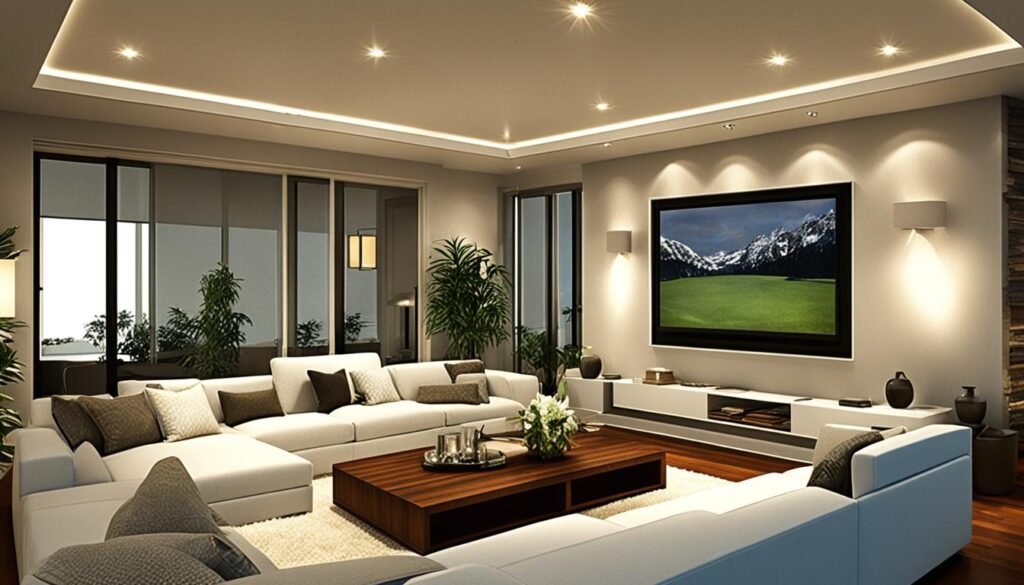
Recessed lighting adds style and light to any home. It’s great for many spaces. Learn how to make the most of it in different rooms:
Kitchen Recessed Lighting
Use reflector trim lights in the kitchen for even, focused light. To place them right, divide your ceiling’s height by two. This is the perfect space between lights. Pick from 4-inch, 5-inch, or 6-inch lights. Choose based on ceiling height and how bright you want the room.
Bathroom Recessed Lighting
Bathrooms need special lights that can handle moisture. Use waterproof lights with a shower trim. They keep the bathroom safe and look good. Go for soft white or bright white lights. They make the space cozy and bright.
Living Room Recessed Lighting
Highlight your living room’s best parts with wall wash lights. These lights spread a soft, even light. It makes the room welcoming. For rooms with slanted ceilings, position the lights well to avoid glare and keep things balanced.
Outdoor Recessed Lighting
Light up your outdoor areas with recessed lights. They’re perfect for patios and decks. Use lights that can brave the weather. They will look great and last long. Mix different lights for a complete, cozy outdoor space.
LED Recessed Lighting
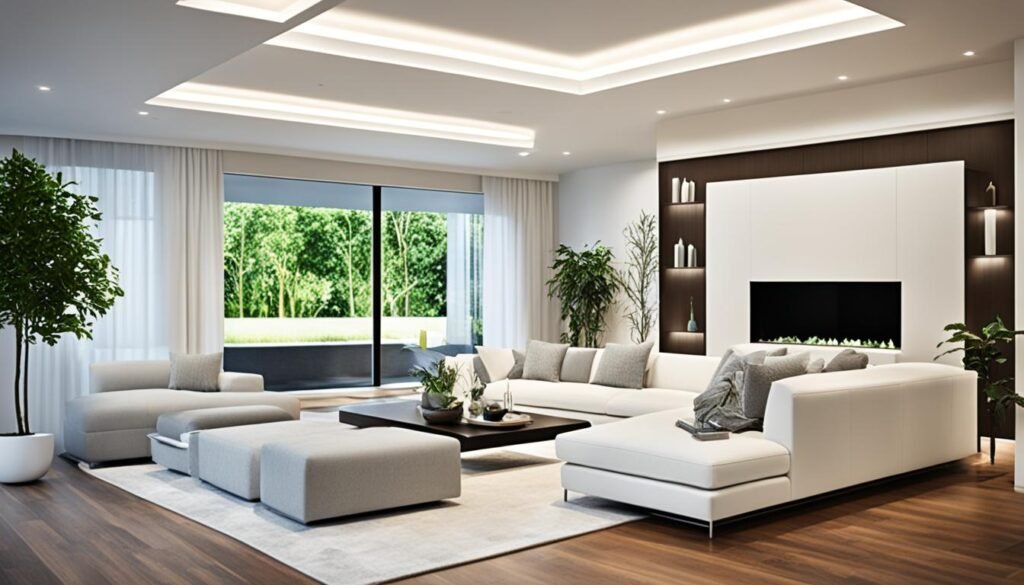
LED recessed lighting is getting more love for saving energy and lasting longer. LED lights last a long time. As they age, they might dim but won’t just die out. Plus, they use less energy than regular bulbs. When picking LED recessed lights, there are two main types to look at.
Integrated LED
Integrated LED lights come as a whole system, with the LEDs built in. You’ll need an expert to install them. They work for years without any need to change bulbs. This means less hassle and more lighting time.
LED Retrofit
For a change from old incandescent lights to LED, there’s the LED retrofit kit. This way saves money and avoids big home changes. There are low-voltage kits too. They cut your electricity bill but cost a bit more upfront.
Recessed lights come in different diameters, from 3 to 6 inches. Smaller ones are great with today’s styles, while bigger sizes fit a classic look and light up a whole space. Canless lights are perfect for places needing a subtle, easy-to-fit light.
Halogen and LED lights are most often used in these fixtures. Warm white is good for cozy spaces, like living rooms and bedrooms. Bright white works best in kitchens and work spots. Finally, daylight bulbs are ideal for areas where you read or study, keeping your eyes sharp.
Recessed Lighting Finishes
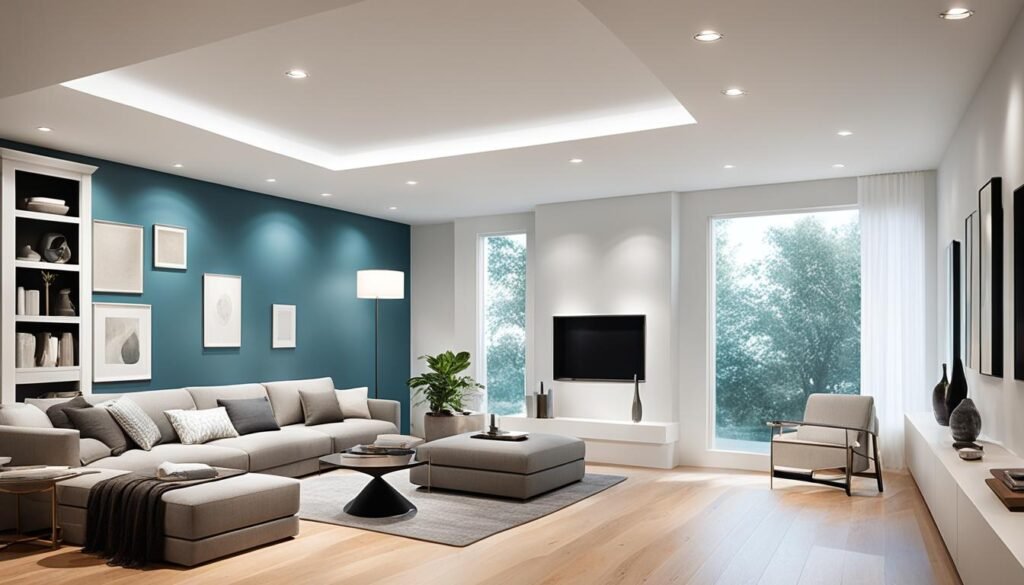
When choosing recessed lighting finishes, you’ll find plenty of options that match your home decor. The top choice is often white, giving a timeless and sleek appearance. For spaces with wooden ceilings, consider metal finishes like nickel, chrome, bronze, or silver. These options mix well, creating a balanced look.
There are many trim styles for recessed lighting, from round to square, and more. Each trim shape affects how light spreads and adds to the room’s look. To set the right mood, pick the trim that fits your lighting needs. You might want a bright focused light or a soft, gentle shine.
Thinking about 4-inch recessed lights? They’re great for emphasizing spots like dining tables. Meanwhile, 5/6-inch fixtures serve as general light or wash walls. Your finish and trim choice should reflect your style and the vibe you want in the room.
Where to Place Recessed Lighting
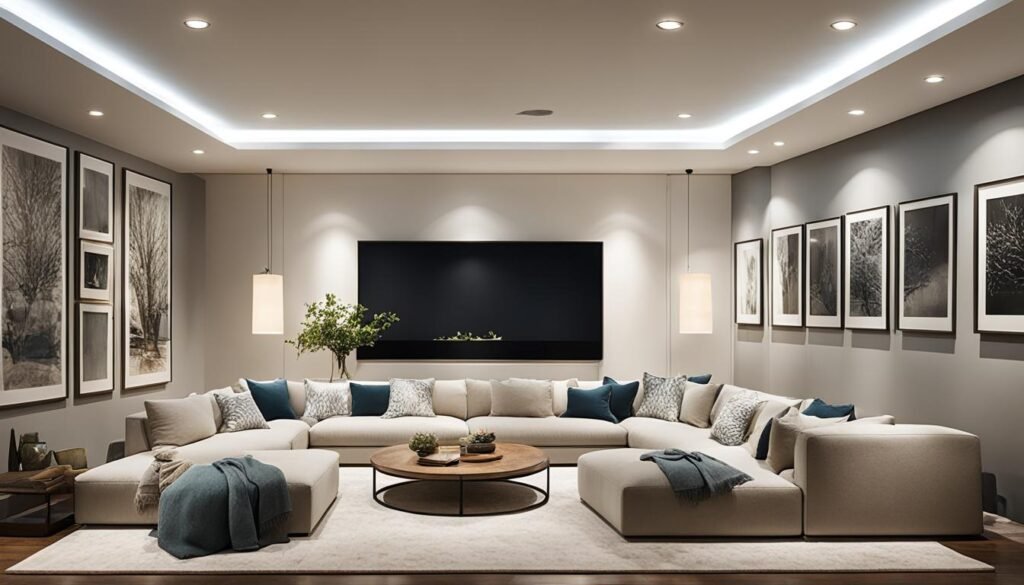
Finding the right spot for your recessed lights is key. It ensures you get the light where you need it most. Here, we’ll go over tips for figuring out the best spots for where to place recessed lighting, recessed lighting spacing, recessed lighting task lighting, and recessed lighting accent lighting.
Spacing Guidelines
For recessed lighting spacing, a simple math trick helps. It’s often best to place lights about half the ceiling’s height apart. So, in an 8-foot high room, you’ll space your lights around 4 feet apart. But remember, you should double that space between lights that are at the ends. First, measure the space you want to light up. Then, you can figure out the perfect placement for your lights.
Task Lighting
Getting the most out of your recessed lighting task lighting is crucial. In places like the kitchen, it’s all about lighting up the work surfaces. This makes sure there are no dark spots. You might light up the edges of counters to prevent shadows. The right setup changes from room to room. Each room’s use will dictate where you should place your lights.
Accent Lighting
Recessed lights can also make rooms look special. They can show off cool design features. To do this, use a special angle for the lights. If you light them at a 60-degree angle using a specific triangle ratio, they’ll look just right. Remember, lights that highlight should be angled at 30 degrees from the ceiling. This reduces harsh light and glare.
Installation and Planning

Installing recessed lighting can be done by a professional or on your own. You can choose to hire a skilled electrician or do it yourself. Each choice has its own factors to think about.
Professional vs. DIY Installation
When you hire a professional, you make sure the recessed lighting is safe and meets the codes. They know how to deal with wires, make the right ceiling cuts, and place the lights correctly. This is crucial in complex spaces with wires or pipes. Professionals also help with the layout, enhancing the lighting’s effects.
Doing it yourself can save money if you understand basic electrical work. It gives you control over where you put the lights. Remember to stay safe, use the correct tools, and learn from reliable sources on how to install recessed lighting.
Lighting Layout and Planning
Getting the recessed lighting layout right is key for good light and looks. There’s a formula for how far apart the lights should be, ensuring space is bright evenly. This math, plus your room’s size and shape, helps decide where lights should go.
For general and task lighting, you measure the space and divide by how many lights you have. This tells you how to space the lights out. For accent lighting, aim to avoid glare by setting the light beams at a 30-degree angle. You can adjust this angle for obstacles like walls or ducts. The formula to find the best angle uses a mathematical rule that deals with the light, wall, and ceiling angles.
Discussing your plans with an expert helps, especially if you’re placing lights near fans. This avoids unpleasant flashing from fan blades and lights not matching up.
Draw your lighting plan to figure out distances and what lights you need.
FAQ
What are recessed lights?
What are the benefits of recessed lighting?
What are the different types of recessed lighting housings?
What are the different recessed lighting trim options?
What size recessed lights should I choose?
What color and temperature options are available for recessed lighting?
How can I use recessed lights in different rooms of my home?
What are the different types of LED recessed lighting?
What finish options are available for recessed lighting?
How should I place recessed lights in my home?
Should I hire a professional or do it myself for recessed lighting installation?
How much does recessed lighting cost?
Source Links
Check out our FREE Calculators on our Resources Page
- https://blog.recessedlighting.com/recessed-lighting-fixtures/
- https://mtcopeland.com/blog/what-is-recessed-lighting/
- https://www.parmida.com/blogs/posts/recessed-lighting-guide
- https://www.ledmyplace.com/blogs/stories/a-guide-to-choose-the-right-color-temperature
- https://blog.recessedlighting.com/recessed-lighting-layout/
- https://www.lightup.com/learn/how-to-layout-recessed-lighting-in-4-easy-steps/
- https://blog.recessedlighting.com/recessed-lighting-placement/
- https://www.ledmyplace.com/blogs/stories/a-guide-to-planning-and-installing-led-recessed-lighting

